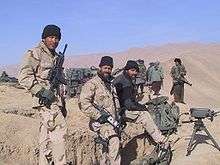Siege of Kunduz
| Siege of Kunduz | |||||||
|---|---|---|---|---|---|---|---|
| Part of the War in Afghanistan and the Afghan Civil War | |||||||
 U.S. Army Special Forces soldiers with Northern Alliance fighters outside Kunduz in November 2001. | |||||||
| |||||||
| Belligerents | |||||||
|
|
| ||||||
| Commanders and leaders | |||||||
|
|
| ||||||
| Strength | |||||||
|
|
10,000 Taliban 3,000 foreign fighters [1] | ||||||
| Casualties and losses | |||||||
|
|
2,000 killed or wounded 3,500 captured [2] 5,000 evacuated by Pakistan through airlifting by the Pakistan Air Force[3] | ||||||
The Siege of Kunduz took place in 2001 during the War in Afghanistan. After the fall of Mazar-i-Sharif on November 9, the focus of the Northern Alliance advance shifted towards the city of Kunduz, which was the last remaining Taliban stronghold in northern Afghanistan.[4]
Timeline
Forces under the command of General Mohammed Daud Daud met up with American Special Forces advisers and advanced to the city of Taloqan, arriving outside the city on November 11. There, Daud's forces attacked without American air support, quickly routing the Taliban and seizing control of the city.
After routing the Taliban at Taloqan, Daud's forces moved to besiege Kunduz. They initially met heavy resistance, leading Daud to decide to entrench his forces around the city and use American air support to weaken the Taliban. For the next eleven days, American aircraft bombarded Taliban positions, destroying 44 bunker complexes, 12 tanks and 51 trucks as well as numerous supply dumps.[2]
Several thousand Taliban and al-Qaeda foreign fighters, along with agents of the Pakistani Inter-Services Intelligence and military personnel, were evacuated by Pakistan Air Force aircraft during the last three days of the siege, in an event that has been nicknamed the Airlift of Evil.
On November 22, Daud's forces captured the nearby town of Khanabad. With their position deteriorating, the Taliban forces inside Kunduz agreed to surrender on November 23.[2] After the Taliban surrender, there were reports of looting by Northern Alliance soldiers as well as reports of the executions of Taliban prisoners.[5]
Human rights groups estimate that several hundred or several thousand captured prisoners died in or after transit to Sherberghan prison.[6] The deaths have become known as the Dasht-i-Leili massacre. Allegations have been made, notably by columnist Ted Rall and Jamie Doran's 2002 documentary Afghan Massacre: The Convoy of Death, that U.S. troops were involved.[7] A July 2009 report in the New York Times caused United States President Barack Obama to order a probe into how the Bush administration handled calls for investigation of the massacre.[8]
References
- ↑ Alliance says Kunduz has been captured - The Independent
- 1 2 3 The United States Army in Afghanistan - Operation ENDURING FREEDOM - October 2001-March 2003
- ↑ Hersh, Seymour M. (2005). Chain of Command. Harper Collins. p. 132. ISBN 978-0141020884.
- ↑ Harding, Luke; Watt, Nicholas; Whitaker, Brian (22 November 2001). "Northern stronghold ready to capitulate". The Guardian. Retrieved 2009-08-15.
- ↑ Kunduz falls, and a bloody vengeance is executed
- ↑ James Risen (2009-07-10). "U.S. Inaction Seen After Taliban P.O.W.'s Died". New York Times. Retrieved 2009-07-14.
- ↑ Rall, Ted (2009-07-17). "Ted Rall: Obama is ignoring an atrocity that dwarfs My Lai". The State Journal-Register. Retrieved 2009-08-01.
- ↑ Anderson Cooper (2009-07-12). "Obama orders review of alleged slayings of Taliban in Bush era". CNN. Retrieved 2009-07-14.
President Obama has ordered national security officials to look into allegations that the Bush administration resisted efforts to investigate a CIA-backed Afghan warlord over the killings of hundreds of Taliban prisoners in 2001.
Coordinates: 36°44′00″N 68°52′00″E / 36.7333°N 68.8667°E